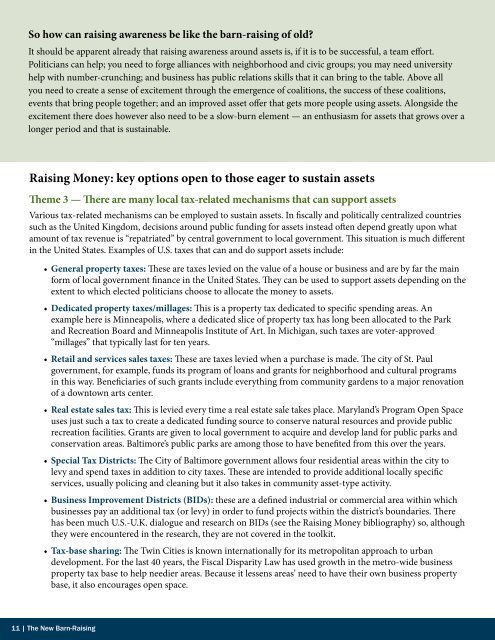bQNs7mR
bQNs7mR
bQNs7mR
You also want an ePaper? Increase the reach of your titles
YUMPU automatically turns print PDFs into web optimized ePapers that Google loves.
So how can raising awareness be like the barn-raising of old?<br />
It should be apparent already that raising awareness around assets is, if it is to be successful, a team effort.<br />
Politicians can help; you need to forge alliances with neighborhood and civic groups; you may need university<br />
help with number-crunching; and business has public relations skills that it can bring to the table. Above all<br />
you need to create a sense of excitement through the emergence of coalitions, the success of these coalitions,<br />
events that bring people together; and an improved asset offer that gets more people using assets. Alongside the<br />
excitement there does however also need to be a slow-burn element — an enthusiasm for assets that grows over a<br />
longer period and that is sustainable.<br />
Raising Money: key options open to those eager to sustain assets<br />
Theme 3 — There are many local tax-related mechanisms that can support assets<br />
Various tax-related mechanisms can be employed to sustain assets. In fiscally and politically centralized countries<br />
such as the United Kingdom, decisions around public funding for assets instead often depend greatly upon what<br />
amount of tax revenue is “repatriated” by central government to local government. This situation is much different<br />
in the United States. Examples of U.S. taxes that can and do support assets include:<br />
• General property taxes: These are taxes levied on the value of a house or business and are by far the main<br />
form of local government finance in the United States. They can be used to support assets depending on the<br />
extent to which elected politicians choose to allocate the money to assets.<br />
• Dedicated property taxes/millages: This is a property tax dedicated to specific spending areas. An<br />
example here is Minneapolis, where a dedicated slice of property tax has long been allocated to the Park<br />
and Recreation Board and Minneapolis Institute of Art. In Michigan, such taxes are voter-approved<br />
“millages” that typically last for ten years.<br />
• Retail and services sales taxes: These are taxes levied when a purchase is made. The city of St. Paul<br />
government, for example, funds its program of loans and grants for neighborhood and cultural programs<br />
in this way. Beneficiaries of such grants include everything from community gardens to a major renovation<br />
of a downtown arts center.<br />
• Real estate sales tax: This is levied every time a real estate sale takes place. Maryland’s Program Open Space<br />
uses just such a tax to create a dedicated funding source to conserve natural resources and provide public<br />
recreation facilities. Grants are given to local government to acquire and develop land for public parks and<br />
conservation areas. Baltimore’s public parks are among those to have benefited from this over the years.<br />
• Special Tax Districts: The City of Baltimore government allows four residential areas within the city to<br />
levy and spend taxes in addition to city taxes. These are intended to provide additional locally specific<br />
services, usually policing and cleaning but it also takes in community asset-type activity.<br />
• Business Improvement Districts (BIDs): these are a defined industrial or commercial area within which<br />
businesses pay an additional tax (or levy) in order to fund projects within the district’s boundaries. There<br />
has been much U.S.-U.K. dialogue and research on BIDs (see the Raising Money bibliography) so, although<br />
they were encountered in the research, they are not covered in the toolkit.<br />
• Tax-base sharing: The Twin Cities is known internationally for its metropolitan approach to urban<br />
development. For the last 40 years, the Fiscal Disparity Law has used growth in the metro-wide business<br />
property tax base to help needier areas. Because it lessens areas’ need to have their own business property<br />
base, it also encourages open space.<br />
11 | The New Barn-Raising


